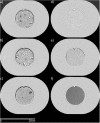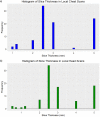Comprehensive Investigation on Controlling for CT Imaging Variabilities in Radiomics Studies
- PMID: 30158540
- PMCID: PMC6115360
- DOI: 10.1038/s41598-018-31509-z
Comprehensive Investigation on Controlling for CT Imaging Variabilities in Radiomics Studies
Abstract
Radiomics has shown promise in improving models for predicting patient outcomes. However, to maximize the information gain of the radiomics features, especially in larger patient cohorts, the variability in radiomics features owing to differences between scanners and scanning protocols must be accounted for. To this aim, the imaging variability of radiomics feature values was evaluated on 100 computed tomography scanners at 35 clinics by imaging a radiomics phantom using a controlled protocol and the commonly used chest and head protocols of the local clinic. We used a linear mixed-effects model to determine the degree to which the manufacturer and individual scanners contribute to the overall variability. Using a controlled protocol reduced the overall variability by 57% and 52% compared to the local chest and head protocols respectively. The controlled protocol also reduced the relative contribution of the manufacturer to the total variability. For almost all variabilities (manufacturer, scanner, and residual with different preprocesssing), the controlled protocol scans had a significantly smaller variability than the local protocol scans did. For most radiomics features, the imaging variability was small relative to the inter-patient feature variability in non-small cell lung cancer and head and neck squamous cell carcinoma patient cohorts. From this study, we conclude that using controlled scans can reduce the variability in radiomics features, and our results demonstrate the importance of using controlled protocols in prospective radiomics studies.
Conflict of interest statement
The authors declare no competing interests.
Figures





References
Publication types
MeSH terms
Grants and funding
LinkOut - more resources
Full Text Sources
Other Literature Sources
Medical

